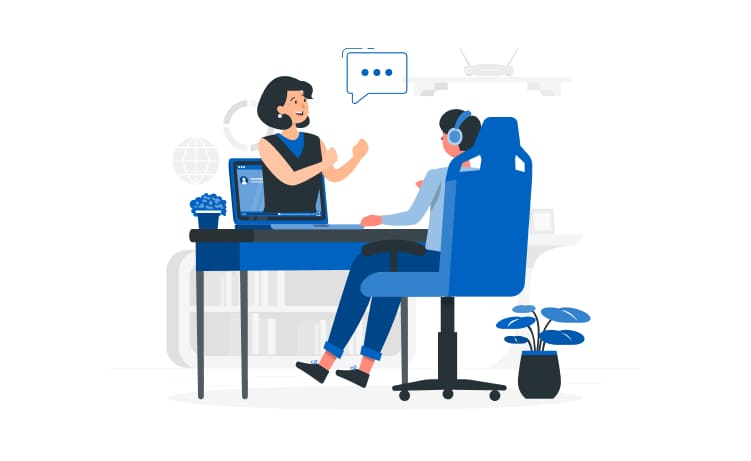
A Complete Guide to e-Learning App Development



Mobile learning is quickly becoming a go-to option for accessing educational content. Thanks to the surge in smartphone and tablet usage, people are increasingly turning to their gadgets for learning. This shift in how we learn gives us considerable insights into how mobile learning is used, what’s trending, and what kind of results it brings.
With the mobile learning market predicted to expand by $46.9 billion in 2024, e-learning has become more relevant than ever. Coursera, Skillshare, Duolingo, and other prominent mobile apps in e-learning are breaking down the constraints of time and place, allowing users to access learning materials whenever and wherever.
Smartphone users love learning, and business owners know this. They have been quick to take up corporate e-learning solutions as well. So, get on board, and in this article, we’ll explore the e-learning application development process and more.
Content
E-learning apps are educational tools you can download onto your devices, like phones and computers. They’re designed to make the learning process engaging and accessible, offering a range of features such as interactive lessons, quizzes, videos, and simulations.
The market niche of digital learning applications offers products for different target audiences and situations. We usually classify the types of online learning apps by training methods and target audiences.

There are 6.84 billion smartphone users globally, and at least 50% of their app downloads are used for educational purposes. And if this isn’t enough to show how far the online educational industry is going, recently the educational app sector made $7 billion.
Experts say we’ll see an 8.9% compound annual growth in the e-learning app market from 2024 to 2030. All this is thanks to the popularization of digital devices, mobile apps, and our human interest and curiosity.
Organizations jump right into e-learning mobile app development because of certain benefits these language learning apps can bring:
Recent data shows that 63% of US high school students and 50% of elementary school students use at least one e-learning application daily.
Online learning is becoming increasingly popular in schools, colleges, preschools, and independent studies. No wonder learning app development has skyrocketed. While researching this subject, you’ll come across various predictions and forecasts, but we want to circle the top e-learning software development trends in this article.
Artificial intelligence has improved the workflow of various industries and proved to be efficient in e-learning. AI and ML technologies are being integrated into e-learning apps to provide personalized learning experiences, automate administrative tasks, offer intelligent tutoring systems, and enhance content recommendation engines.
E-learning applications implemented with AI and ML often include automated graders, chatbots, adaptive learning, and predictive analytics. These features can ease repetitive, routine work and simplify feedback-giving.
In several ways, big data can be implemented in educational apps to enhance the learning experience, personalize content, and improve outcomes.
E-learning apps can collect and analyze large volumes of data generated by learners’ interactions with the platform. This data includes information such as time spent on different activities, completion rates, assessment scores, and navigation patterns. By analyzing this data, educational institutions can gain insights into learners’ progress, identify areas of strength and weakness, and tailor instruction to meet individual needs.
Following this trend, virtual educational apps can create personalized learning paths, adaptive learning process, curriculum optimization, and content recommendations.
In e-learning apps, AR can give extra details about real-world objects or places, making it easier to understand and more enjoyable for learners. It can provide users with interactive simulations, allowing them to manipulate virtual objects and conduct experiments.
With the right approach, even the most boring information can be saturated, lively, and engaging. Using MR to blend physical and virtual worlds will allow learners to interact with physical and digital elements and enhance their educational experience.

And, of course, VR creates fully immersive digital environments that transport learners to different places, times, or scenarios. In educational apps, VR can simulate realistic training scenarios, virtual labs, or historical reconstructions.
This is accurate for Glorium Technologies, too. We’ve been on the bandwagon of developing trends in the e-learning industry. And if you’d like to see the results of VR and AR implementation, check out our case study about creating a mobile educational platform for future doctors.
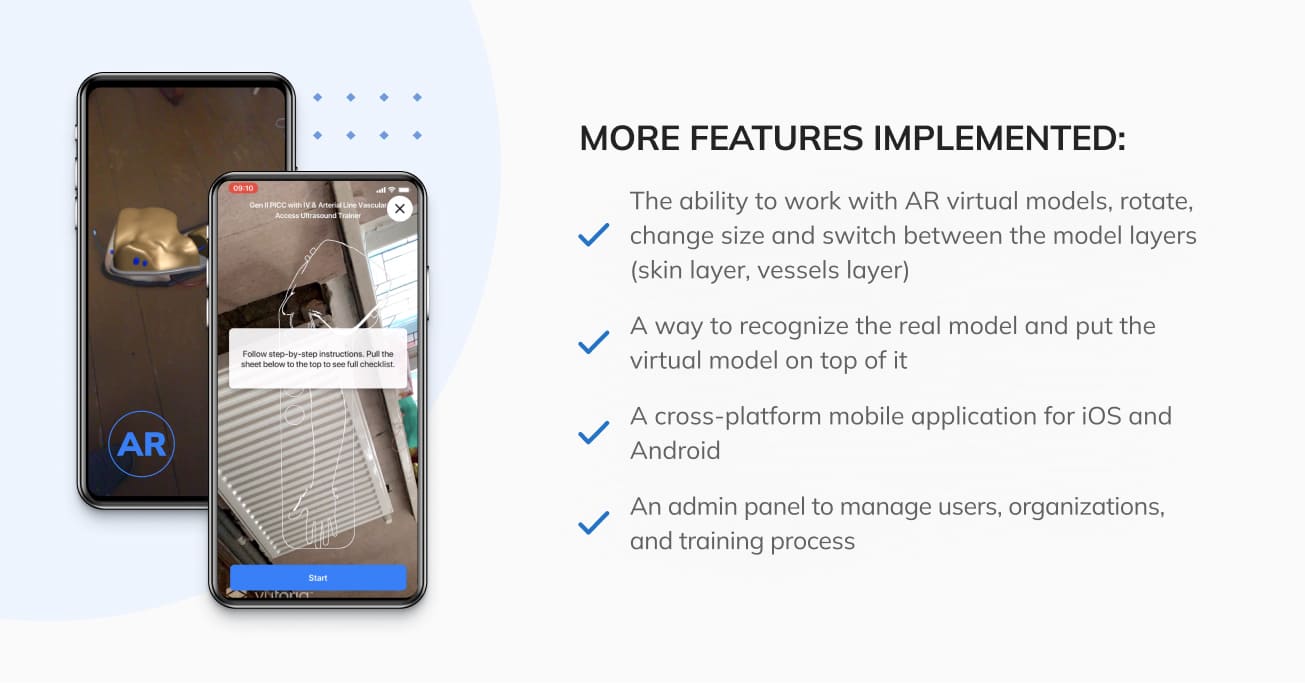
While some apps provide users with fixed materials, others allow them to generate and share their own with peers.
These materials can be discussion forums where users can participate, ask questions, and give insights; collaborative projects that allow them to share files; peer feedback projects that grow awareness and accessibility of the app; and user-created content libraries.

Now that you understand eLearning apps and how businesses use them let’s discuss the development process.
eLearning App development involves several essential steps to ensure a smooth and effective process. These steps typically include market analysis, defining the target audience, working on UI/UX design, defining MVP, selecting the monetization method, and testing. Let’s delve into each of these stages:
Taking the time to dive deep into analysis is crucial in shaping a solid business strategy moving forward. Before diving headfirst into learning app development, it’s essential to understand what makes your design stand out and predict the demand for it. One way to do this is by closely examining what your competitors are up to in the niche you’ve chosen.
That’s where SWOT analysis comes in handy. It’s like a Swiss Army knife for strategic planning, helping you pinpoint a few key things:

This step is crucial for pinpointing your target audience and potential users of the e-learning app. Take some time to understand who they are – consider their primary needs, desires, and even their approximate age. This information will lay the foundation for crafting a more tailored and practical eLearning app experience.
When defining your target audience, ask yourself questions like:
Understanding what your audience wants will give you valuable insights that can help you with your online learning app development.
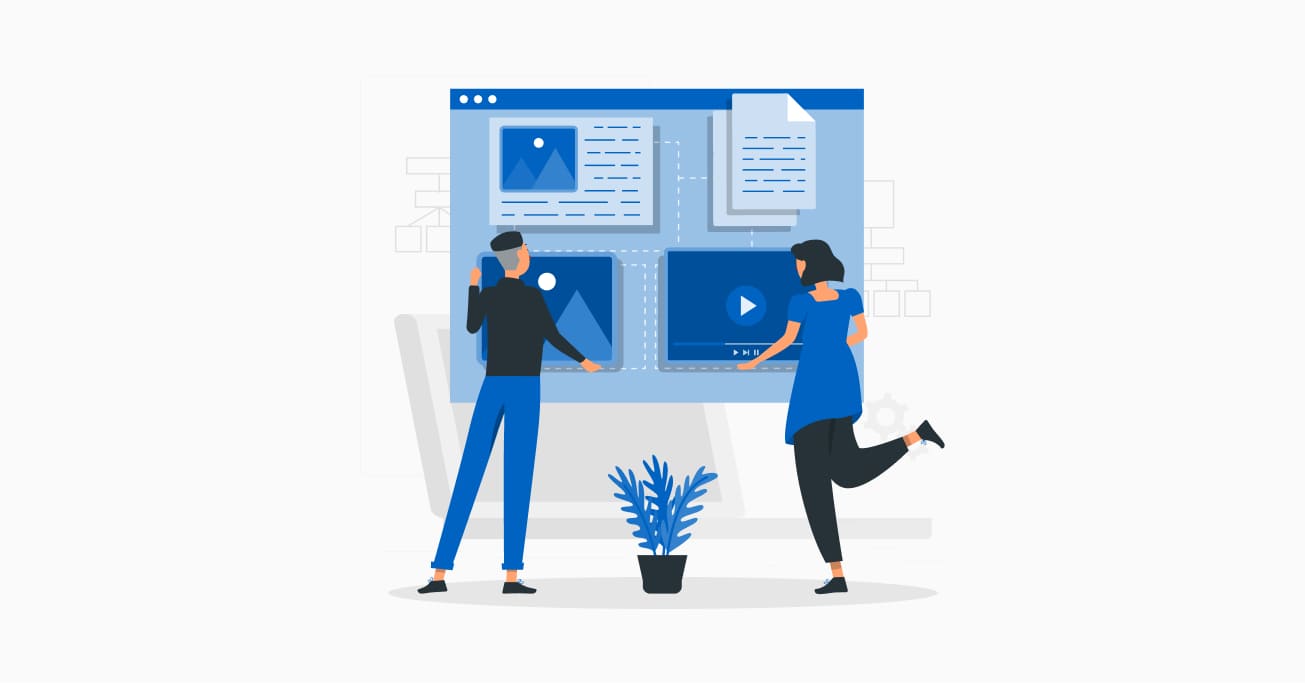
At this stage, it’s essential to consider your future target audience when working on the UI/UX of your e-learning app. Let’s break it down:
First off, think about who your users will be. For instance, if your e-learning app is geared towards kids, it should have a bright and playful design that’s easy for them to navigate. Keeping things simple, with intuitive controls that even the youngest learners can grasp, will help your business reach and retain your audience.
On the other hand, if your e-learning app targets an older demographic, the UX designer should opt for a more subdued color palette and a clean, minimalist interface. The key here is simplicity – avoid cluttering the screen with too many elements, which can overwhelm and deter users.
Brevity is critical in UI/UX design regardless of your audience. Professional UI/UX designers usually aim for a clean, streamlined layout that guides users seamlessly through the app without unnecessary distractions.
Remember, an overloaded design can be off-putting and cause users to lose interest, so keep it simple and focused on delivering a smooth and enjoyable learning experience.
Think of a minimally viable product (MVP) as the starting point for your e-learning app – it’s like laying down the basic groundwork before adding all the bells and whistles.
MVP is a version of your e-learning app that includes only the most essential features needed to meet the initial needs of your users. It’s about getting something out there quickly and efficiently without bogging it down with unnecessary extras. This approach offers several key advantages:
After you’ve defined your target audience and know what your e-learning app will look like, you need to select the monetization method.
Let’s explore some popular options and how they work:
The choice is yours, but remember to consider your audience, the type of content you’re offering, and the overall user experience. By choosing the right approach, you can ensure that your e-learning app provides value to users and generates revenue to support its ongoing development and growth.
We know this is one of the most essential steps of learning app development after completing dozens of projects. Once the development phase is completed, it’s time to ensure that our e-learning app is in tip-top shape before releasing it to the world. We usually conduct thorough testing to identify and crush bugs in the code. This ensures that the final product is polished and ready for prime time.
Once everything checks out, we’re ready to launch the e-learning app on platforms like the App Store and Google Play. Our apps are designed to meet the strict requirements of Apple and Google, so they typically sail through the moderation process without a hitch. So make sure your app also follows these essentials.
No matter which e-learning app you’re looking at or who it’s designed for, it must have certain key features to be effective.
Users need a way to sign up and manage their accounts. This typically involves using an email address, phone number, and password. Some platforms may also offer the option for quick sign-up through social media platforms like Facebook.
E-learning platforms essentially serve as catalogs of educational materials. A robust search feature helps users find courses relevant to their interests or based on their past enrollment history. This can include a search bar for keywords, categorized browsing, filters for language, cost, and level, as well as recommendations based on selected or popular courses.
Users benefit from a dashboard where they can access helpful information about their progress. For example, students can track the courses they’ve completed, hours spent learning, ratings, attendance records, and earnings.
Courses typically comprise various materials such as videos, podcasts, interactive tutorials, or online discussions. Some platforms even incorporate gamified elements to enhance engagement. Each course should have a dedicated page providing details such as course description, author information, material list, and topics covered. Certificates confirming course completion and feedback from previous participants can further enhance the trust and credibility of course materials.
For paid online courses, users should have convenient and secure payment options. This might include bank cards, popular payment systems, and other trusted methods. User profiles should integrate with a secure payment gateway for seamless transactions. Additionally, profiles should maintain basic information, purchase history, and customizable settings.
Sending notifications about new courses, events, or promotions can keep users engaged. However, it’s crucial to avoid overwhelming them with excessive notifications. A balanced approach, such as periodic updates rather than constant alerts, is more effective.
Teachers need tools to manage their courses effectively. This is a learning management system that includes essential features for monitoring course progress, tracking student participation and achievements, and facilitating discussions. Teachers should also be able to create and update their courses as needed, ensuring flexibility and relevance.
This might be the most crucial subject in this guide for some readers. Businesses often make decisions after calculating costs, so it’s only smart to have a little forecast of how much an eLearning app creation will cost.

Many factors play a role in determining the price, like the type of in-app purchases, the size of the app, design, features, functionalities, and more:
The complexity and features of the application
If you opt for only basic functionality, the development price will be cheaper. But if you want to develop an e-learning app with various features and complex components, you’ll find the price higher.
The location of the development team
The in-house development team will cost you a lot of money, so assuming you’re outsourcing these services, the team’s location will often dictate the price.
Mobile app developer quantity
The number of developers required directly correlates with the program’s complexity. In other words, the more intricate the software, the greater the need for a diverse team of specialists who must be compensated for their work.
The overall cost of such an app development is determined by the total hours worked by each specialist on the project. On average, specialists charge around $50-$60 per hour. For a typical project totaling around 2,000 hours, the cost of an average eLearning app development ranges from $100,000 to USD 120,000.
If you’re planning to create your own educational app, you might find there are two options: forming an in-house team or outsourcing the work. Outsourcing involves collaborating with an established external team on a project-by-project basis. Each option has its advantages and drawbacks, but we typically advise against hiring an in-house team.
Building an internal team entails additional effort, time, and financial investment for:
Time is a crucial factor to consider, especially for businesses that can’t afford to delay progress. While an in-house app development might allow for a more leisurely pace, the landscape changes dramatically when entering a fiercely competitive market with a new mobile product.
Outsourcing your e-learning app development to an established e-learning app development company brings several benefits. These companies have dedicated teams with expertise in developing educational apps, allowing you to tap into their knowledge and experience without the overhead of hiring and managing an in-house team.
Choosing the right partner or eLearning app developers is a challenge. After 13+ years on the market, we know what to look for, so we’ve prepared a guide for you. Save this checklist from Glorium Technologies experts.
When your product is a mobile app, your users are intimately close to it – they literally interact with it using their fingertips, unlike PC applications that rely on a keyboard and mouse.
A great mobile app design surpasses mere aesthetics—it must be intuitive, engaging, and responsive to user needs and expectations. Moreover, the design must adapt seamlessly to the various devices and screen sizes. Seasoned designers understand this inherently, but discussing these nuances with your app development partner is still beneficial.
One of the simplest ways to measure the expertise of a company’s designers is by examining user feedback on their apps. Pay attention to comments regarding usability: complaints about confusing navigation, redundant screens, cluttered interfaces, or inconsistencies in style elements can provide valuable insights.
Professionals will dive into thorough research before starting the development process. This research helps evaluate the market landscape and forecasts. It includes analyzing competitors and conducting consumer research. The insights gained from this process can significantly influence user interface and experience decisions and monetization strategies or even lead to reconsidering the entire app concept.
Don’t overlook this step; seek out an app development partner who values thorough research just as much.
If your e-learning app is designed exclusively for Android, it won’t function for iOS, and vice versa. That’s why you need to hire a team with cross-platform development experience.
Opting for cross-platform development proves to be the most cost-effective route. This approach allows for swift product launches and budget savings while delivering an application that closely resembles a native experience, thanks to modern frameworks like React Native.
Completion of the project shouldn’t be the end of collaboration. A professional team should provide you with further support for bug fixes and necessary changes in case a new version of iOS and Android is released or something unexpected happens.
We can’t stress this enough. Yes, it would help to choose a team with expertise, professional developers, and detail-oriented UX designers, but check their reputation, communication methods, and more. Make sure you’re working with someone who has lots of satisfied customers.
We spoke about satisfied customers in the previous paragraph. Ensure your development partner has a portfolio and social proof of their work. Please do your own research, but ask them to provide relevant portfolio items and client comments.
We mentioned earlier that choosing a monetization method is a crucial step in educational app development. It may be one of the final steps, but ensure your development partner can recommend various techniques and help you reach your final goal.
After working with various brands across the globe, receiving their feedback, and writing case studies case by case, we know that our clients benefit from these advantages when working with Glorium Technologies:
We follow the steps of the above guide to educational app development but in more detail. Glorium Technologies can create mobile and web applications with the help of our experienced developers, designers, researchers, QA engineers, and more. If you’d like to learn more about how we do our job, visit our Custom Software and App Development Service Page.
It can take 500 to 2000 hours on average, depending on the size of the platform and the number of features.
The popularity of similar web apps has risen for language learning, acquiring new skills, and more. There’s no short answer to this, but let’s try. Start with business analysis and determine your desired market segment. List the main features of your Udemy-like e-learning app and choose the monetization method.
Reread our guide for detailed directions and contact Glorium Technologies for insight from experts.




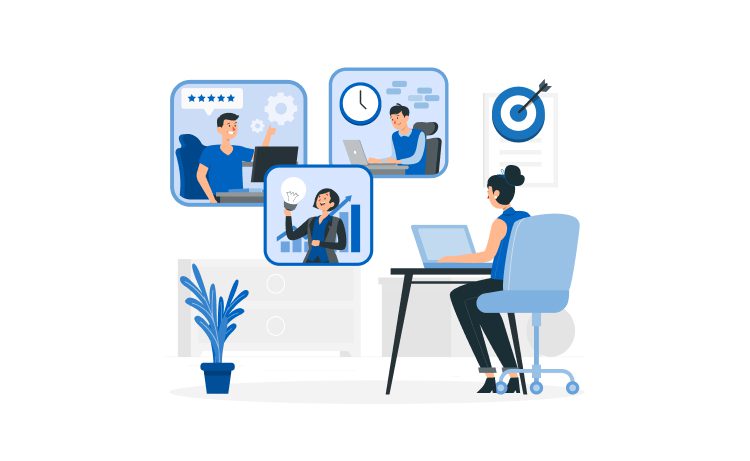



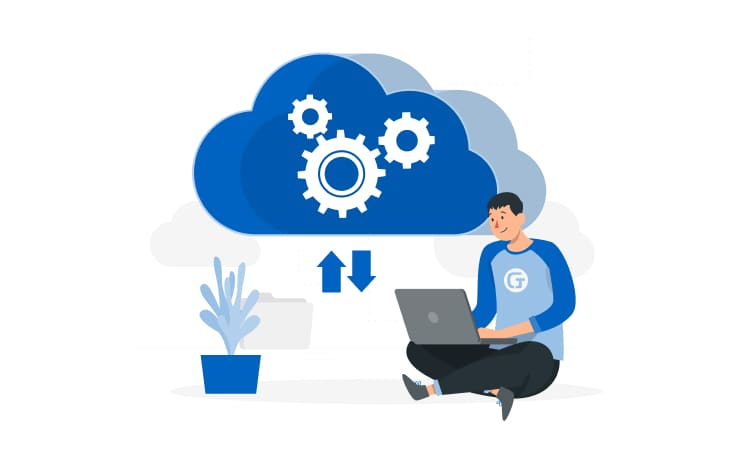
| Cookie | Duration | Description |
|---|---|---|
| cookielawinfo-checkbox-analytics | 11 months | This cookie is set by GDPR Cookie Consent plugin. The cookie is used to store the user consent for the cookies in the category "Analytics". |
| cookielawinfo-checkbox-functional | 11 months | The cookie is set by GDPR cookie consent to record the user consent for the cookies in the category "Functional". |
| cookielawinfo-checkbox-necessary | 11 months | This cookie is set by GDPR Cookie Consent plugin. The cookies is used to store the user consent for the cookies in the category "Necessary". |
| cookielawinfo-checkbox-others | 11 months | This cookie is set by GDPR Cookie Consent plugin. The cookie is used to store the user consent for the cookies in the category "Other. |
| cookielawinfo-checkbox-performance | 11 months | This cookie is set by GDPR Cookie Consent plugin. The cookie is used to store the user consent for the cookies in the category "Performance". |
| viewed_cookie_policy | 11 months | The cookie is set by the GDPR Cookie Consent plugin and is used to store whether or not user has consented to the use of cookies. It does not store any personal data. |